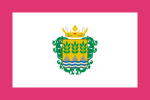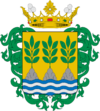Vélez-Blanco facts for kids
Quick facts for kids
Vélez-Blanco, Spain
|
|||
|---|---|---|---|
|
|||
| Country | Spain | ||
| Community | Andalusia | ||
| Province | Almería | ||
| Area | |||
| • Total | 441 km2 (170 sq mi) | ||
| Elevation | 1,070 m (3,510 ft) | ||
| Population
(2018)
|
|||
| • Total | 1,938 | ||
| • Density | 4.395/km2 (11.382/sq mi) | ||
| Time zone | UTC+1 (CET) | ||
| • Summer (DST) | UTC+2 (CEST) | ||
Vélez-Blanco is a small town in the Almería province of Spain. It is part of the Andalusia region. In 2018, about 1,938 people lived there.
The town covers an area of about 441 square kilometers. It is located high up, at 1,070 meters above sea level. Vélez-Blanco is about 164 kilometers away from Almería, the capital city of the province. It belongs to a region called Los Vélez.
Vélez-Blanco is famous for its history and special places. The Castillo de Vélez-Blanco is a beautiful castle built in the 1500s. Other important buildings include the Church of Santiago and the Convent of San Luis.
One of the most amazing spots is the Cave of the Signboards. Inside, you can see ancient cave paintings. One painting, called the Indalo, shows a human figure. This symbol has become a famous sign for the whole Almería province. The cave was recognized as a National Historic Monument in 1924. Later, in 1998, UNESCO declared it a World Heritage Site.
People from Vélez-Blanco and a nearby town, Vélez-Rubio, share the same nickname: egetano or egetana. Vélez-Blanco first used this term for its residents.
Contents
Exploring Vélez-Blanco's Geography
Vélez-Blanco includes several smaller areas called districts. These are Topares, El Piar, and Santonge. Santonge is special because it also has ancient prehistoric paintings.
Waterways of Vélez-Blanco
The area has many water sources. These waters flow into two important rivers: the Segura River and the Guadalquivir River. They connect through a stream called Cañada del Salar. Some studies even suggest that the Cañada del Salar stream might be where the Guadalquivir River begins!
Population Changes in Vélez-Blanco
Like many towns in this region, Vélez-Blanco saw a big drop in its population between 1950 and 1980. This means many people moved away. While this trend has slowed down, the population is still decreasing slowly.
| Historical population | ||
|---|---|---|
| Year | Pop. | ±% |
| 1999 | 2,144 | — |
| 2000 | 2,061 | −3.9% |
| 2001 | 2,043 | −0.9% |
| 2002 | 2,001 | −2.1% |
| 2003 | 2,052 | +2.5% |
| 2004 | 2,051 | −0.0% |
| 2005 | 2,126 | +3.7% |
| 2006 | 2,165 | +1.8% |
| 2007 | 2,219 | +2.5% |
| 2008 | 2,223 | +0.2% |
| 2009 | 2,259 | +1.6% |
| 2010 | 2,282 | +1.0% |
| 2011 | 2,276 | −0.3% |
| 2012 | 2,238 | −1.7% |
| 2013 | 2,066 | −7.7% |
| 2014 | 2,064 | −0.1% |
| 2015 | 2,035 | −1.4% |
| 2016 | 1,984 | −2.5% |
| 2017 | 1,918 | −3.3% |
| 2018 | 1,938 | +1.0% |
| Source: INE (Spain) | ||
Famous Landmarks to Visit
- Castillo de Vélez-Blanco - This historic castle is a must-see attraction.
A Look at Vélez-Blanco's History
The town of Vélez-Blanco stands on the same spot where a Muslim settlement once existed until the 1200s. They built a fortress, and later, the famous Castle of the Marquises de los Vélez was built on its foundations.
The oldest part of the town is called La Morería. Its houses were built in steps around the castle. The town was once protected by two walls. The first wall surrounded the fortress and the main mosque, which is now the Magdalena Church. The neighborhood of La Morería was located between these two walls.
The outer walls stretched from the Cinco Caños (Five Pipes) spring down to Mesón square. They also went along Palacio and Calasparra streets. There was a gate here that led to the orchards. Another gate was at Caños de Caravaca. From there, the wall climbed a hill to meet the Cinco Caños gate. Areas outside these walls were known as suburbs.
Building the Castle and New Neighborhoods
In 1507, construction began on the Fajardo Castle. To build it, parts of the old Arab fortress were taken down. The new castle was then built on its strong foundations.
The town grew beyond the Morería neighborhood. New streets were added to house the Christian population. During the 1500s, the town expanded up the hillside and into flatter areas. The Church of Santiago was built and became a central point for the town's social and business life.
Another very important building for the town's growth was the Convent of San Luis Obispo. Don Luis Fajardo ordered it to be built between 1601 and 1615. It was located across the Barranco de las Fuentes, a small valley. Franciscan monks lived there until 1835. Later, from 1916 to 1996, Franciscan Concepcionistas nuns occupied it.
This convent soon became the center of a new part of town. This led to the creation of a new neighborhood, or barrio. This new area grew in the 1700s. It was built around Calle San Francisco, with houses following the natural shape of the land.
Most houses in Vélez-Blanco are simple, with one or two floors. They have white walls and tiled roofs. In the 1600s and 1700s, the town's population grew. This helped complete the historic town center. Today, the town's shape is defined by the Vélez-Rubio - María road that crosses it. The Castle hill and Las Fuentes are to the west. Steep slopes are to the north and south. To the east, the town is bordered by the Barranco de Canastera and one of the fountains.
See also
 In Spanish: Vélez-Blanco para niños
In Spanish: Vélez-Blanco para niños



